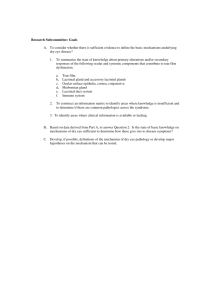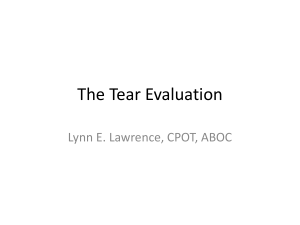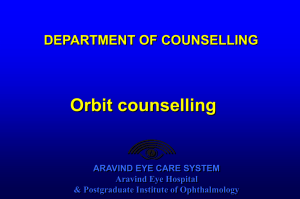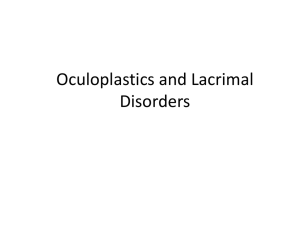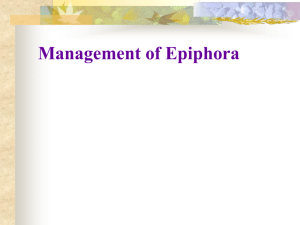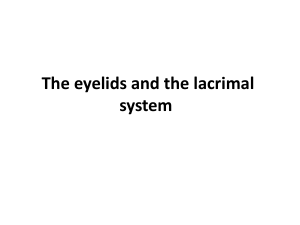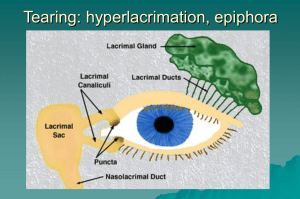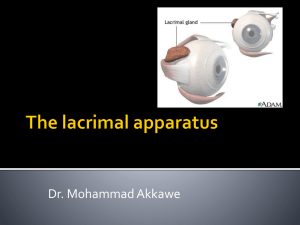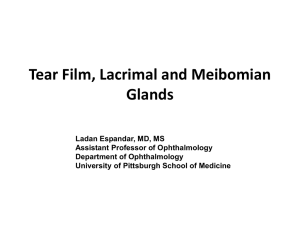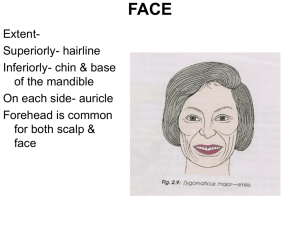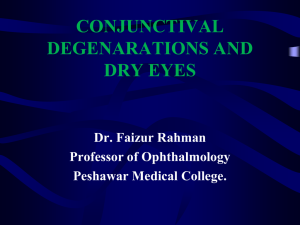WATERING EYE
advertisement
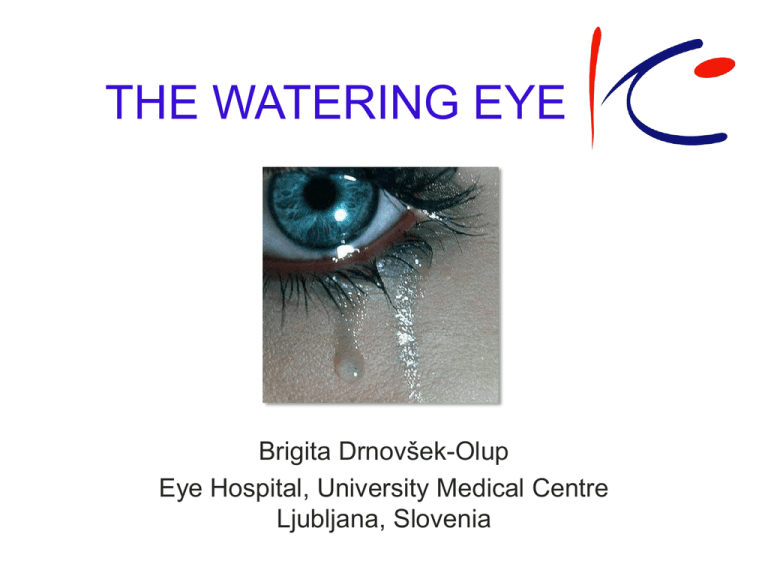
THE WATERING EYE Brigita Drnovšek-Olup Eye Hospital, University Medical Centre Ljubljana, Slovenia Introduction • Watering eye is an extremely common ocular symptom. Watering eye lacrimation epiphora Failure to differentiate these two conditions can result in unwarranted and improper medication of a large number of patients. THE WATERING EYE • Lacrimation is watering that occurs secondary to excessive tear production in the presence of a normal excretory system. • Epiphora is watering that occurs secondary to abnormal excretory system in the presence of normal tear secretion. Secretory system • Lacrimal gland: orbital part (2/3) palpebral part (1/3) • Accessory lacrimal glands: Krause Wolfring Secretory system • Normal tear secretion is necessary to keep the ocular surface moist. The tears form a thin film, which integrity is crucial for normal corneal physiology. • Tear composition and secretion - three layers: • the mucin layer: secreted by the goblet cells; alters the surface tension of the tears and increases its adherence to the cornea. • the aqueous layer: secreted by the accessory lacrimal glands (Krause and Wolfring) or in the presence of ocular irritation the main lacrimal gland. • the oily layer: secreted by the Meibomian glands; prevents tear film evaporation. A new tear film model showing additional layers and interfaces (a six-layer model): Previous reports had vastly underestimated the thickness of mucus. Ocular surface and lacrimal glands function as an integrated unit. Secretory system • Pathology of the tear film: • deficiency of the aqueous layer - keratoconjunctivitis sicca. • deficiency of mucous or meibomian secretions instability of the tear film (compensatory excessive aqueous secretion - paradoxical watering). Lacrimal drainage system - anatomy The anatomy of tear production and flow The anatomy of tear production and flow Lacrimal drainage system - physiology • The puncta should be open and in firm apposition to the globe. • The tears drain into the puncta from the tear meniscii along the lid margins by capillary action and also due to the negative pressure created by the sac. • As the sac is surrounded by the orbicularis muscle, normal blinking movements result in negative pressure in the sac when the lids are open and positive pressure when, the lids are closed. Lacrimal drainage system physiology -lacrimal pump • The valves at the common canaliculus (Rosen Muller) and nasolacrimal duct opening into the nose (Hassner) ensure unidirectional flow of tears into the nose. Paralysis of the orbicularis can result in epiphora due to lacrimal pump failure. Lacrimal pump Causes of watering eye Lacrimation (hypersecretion): • Secondary to ocular inflammation or surface disease. • Emotional distress • Irritation of the eyes ( smoke, dust, foreign bodies, injury) Causes of watering eye Epiphora:(defective drainage): compromise of the lacrimal drainage system: • a) malposition of the lacrimal puncta (e.g. ectropion) • b) obstruction (anywhere along the lacrimal drainage system, from puncta to the nasolacrimal duct) • c) lacrimal pump failure (lower lid laxity or weakness of the orbicularis muscle) Aquired obstruction • Primary punctal stenosis (chr. blepharitis, idiopathic primary stenosis, herpetic infection of eyelid, irradiation, cicatrizing conjunctivitis and trachoma, cytotoxic drugs, porphyria cutanea tarda, acrodermatitis enteropathica) • Secondary punctal stenosis (punctal eversion) • Canalicular obstruction (cong., trauma, herpetic infection, drugs and irradiation, chr. dacryocystitis) • Nasolacrimal duct obstruction (idiopathic stenosis, trauma, previous surgery, granulomatous disease, tumours) • Dacryolithiasis Congenital obstruction • Nasolacrimal duct obstruction • Congenital dacryocele Evaluation of an adult patient with watering eye • Pseudoepiphora: epiblepharon, distichiasis, trichiasis, glaucoma… The lacus is dry and syringing is patent. • Lacrimation secondary to corneal disorders or conjunctivitis is obvious due to associated symptomatology or on examination. Two conditions which can be mistaken for true epiphora are dry eye syndrome and blepharitis. • Dry eye: Dry eye secondary to deficiency of mucous or meibomian secretions can have paradoxical watering. A diagnosis is usually based on reduced lower tear meniscus, and increased debris in tear film on slit-lamp examination. Increased tear break-up time (BUT) and reduced Schirmer's strip wetting corroborate the diagnosis. Evaluation of an adult patient with watering eye • Blepharitis: thickened, hyperaemic lid margins with scales deposited on the lashes, blocked meibomian openings, excessive abnormal meibomian secretions, and frothy discharge on the lid margins. • True epiphora: secondary to either an anatomical obstruction or functional deficiency like ectropion or lacrimal pump failure – differentiated on the basis of syringing. Evaluation • External examination: – The puncta and eyelids (ectropion, punctal obstruction – eyelash, conjunctivochalasis, eversion of punctum by large caruncle, canaliculitis, canturion syndrome – prominent nasal bridge) – The lacrimal sac (palpation) Evaluation tests • Fluorescein disappearance test (no dye after 3 mins) • Probing and irrigation (hard stop or soft stop) • Jones dye testing (the primary and secondary test) • Contrast dacryocystography • Nuclear lacrimal scintigraphy Probing: a) hard stop, b) soft stop Jones dye testing: a) primary, b) secondary Dacryocystography Diagnostic procedures Treatment • Lacrimation - treatment usually medical. • Dry eye: treatment consists of topical lubricants. • Blepharitis: treatment consists of lid scrubs, oral tetracycline and topical lubricants. Treatment • Ectropion or entropion - lid repair. • Primary punctal stenosis – dilatation with Nettleship dilatator, punctoplasty. • Secondary punctal stenosis – Ziegler cautery, medial conjunctivoplasty, Lower lid tightening. • Canalicular obstruction – partial: intubation; total: canaliculodacryocystorhinostomy and intubation or CDCR and the insertion of Lester Jones tube. Treatment • Nasolacrimal duct obstruction infants: massage, probing; adults: DCR, TCL-DCR, intubation, stents, balloon dilatation. • Dacryolithiasis – DCR • Congenital dacryocele - probing Lacrimal surgery • • • • • Conventional dacryocystorhinostomy Lester Jones tube Endonasal surgery Endocanalicular laser DCR Balloon dacryocystoplasty 1. Insertion of light probe into lacrymal sac. 2. Transillumination of nasal bone. 5. Insertion & fixation of stents. 7. Osteotomy with stents at end. 6. Haemostasis & tamonade. 8. Open osteotomy 1 mo post-op. Transcanalicular laser DCR Conclusions • The proper diagnosis and treatment of watering eye is important due to its impact on the outcome of many other ocular procedures. • Undiagnosed and untreated watering eye substantially decreases the patients' quality of life, visual acuity and impairs social contacts. Thank You!
